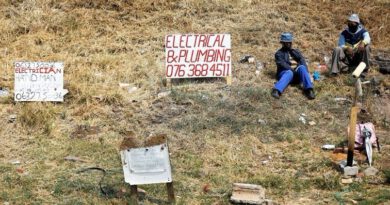SA’s worst week of load shedding to hit economy hard
South Africa’s worst week of load shedding, with today (Friday) marking the fourth straight day of Stage 6 rolling blackouts, is going to hit the economy hard.
While the actual economic impact is yet to calculated, economists and business leaders are already warning that the toll will run into billions of rands and will have other ramifications such as lost investment, a negative impact on SA’s already sub-investment grade credit rating and deteriorating business- and consumer confidence levels.
Read:
Eskom extends Stage 6 load shedding
No protest planned at Eskom’s head office on Friday, says Numsa
The last time SA had Stage 6 load shedding was on 9 December 2019 and it lasted for less than a day.
This week’s crisis comes off the back of a wildcat strike by Eskom workers, which saw load shedding going to Stage 4 on Sunday and Eskom then being forced to escalate it to Stage 6 on Tuesday, after most of its staff did not pitch for work.
At Stage 4 load shedding alone, Nova Economics calculates that the economic cost amounts to around R950 million a day. At Stage 6, this is likely to be closer to R1.5 billion a day. Other economic impact estimates are higher.
Speaking on Moneyweb’s SAFM Market Update radio show on Thursday night, Alexforbes chief economist Isaah Mhlanga, said Stage 6 load shedding alone may have already cost the economy R4.1 billion a day*.
This means the economic hit, between Tuesday and Thursday, could tally to at least around R12 billion. The total for the week is likely to be much higher, considering Stage 4 being effective since Sunday.
Read:
Why is South Africa facing its worst power crisis in two years?
Load shedding: Stage 4 and counting …
On Thursday, the JSE closed over 2% weaker, weighed down by the extension of Stage 6 load shedding and uncertainty around possible further strike action at Eskom.
The rand also extended its losses against the US dollar, trading around R16.30 to the greenback after starting the week around R15.86.
The weakening rand spells more bad news for South Africans and Eskom, with more fuel price hikes expected next week both for petrol and diesel. On Thursday, JSE-listed property giant Growthpoint also warned of diesel shortages, which are affecting its capacity to use generators in the face of Stage 6 load shedding.
Read:
Growthpoint struggles to secure diesel amid load shedding
Eskom is burning more diesel than ever to keep the lights on
Eskom may run out of money for diesel, as global prices soar
Commenting on the impact of Stage 6 load shedding and market moves on Thursday, PwC economist Lullu Krugel said: “The markets are fickle. I’m hoping that it’s not a long-term trend that we are seeing, but I’m not surprised that it [load shedding] obviously has an impact on the way that investors are viewing the markets.”
Longer-term impact
She was however more concerned about the longer-term impact this could have on investment and SA’s economic growth.
Should Eskom’s challenges continue, Krugel warns that this will risk stifling the country’s already sluggish economic growth even further.
“We are of the opinion that with the levels of load shedding we saw last year, we potentially lost about 250 basis points [2.5%] of growth,” she tells Moneyweb.
“Now we are already at record levels [of load shedding] if you are comparing to last year. And, in all probability, we will exceed that number of hours of load shedding this year.
“If you’re looking at an economy that should’ve grown three percentage points faster or four percentage points faster, its half a million jobs potentially that we are losing out on. Who knows, if we were able to grow at 4% or 5% GDP what it would’ve meant in terms of attracting more investors and for job creation,” adds Krugel.
Read: SA has lost well over a million jobs already due to load shedding – Schüssler
According to Krugel, the country’s increasingly unstable power supply will not only drive away potential new investors but also cause investors that already have a presence here to halt expansion plans and consider redirecting some spend towards mounting input costs.
She says Stage 6 load shedding “will definitely lower investment appetite in the country”.
“If I am an investor looking at the short-term impact of this [Stage 6 load shedding] on the economy and then weighing it up against growth in other markets – in this already very high inflationary environment – South Africa becomes less attractive.”
Public Enterprises Minister Pravin Gordhan and Eskom executives tried to allay fears in a briefing on Tuesday, saying the power utility and unions would resume wage talks on Friday. Having agreed with unions to go back to the negotiating table, they expected to see workers back at work (temporarily) before Friday and for SA’s power supply to stabilise.
Read:
Eskom warns it may take ‘days to weeks’ before its systems recover
Gordhan hopes all Eskom staff will return to work, as wage negotiations resume
However, with many workers having not pitched for work, Eskom had no option but to extend Stage 6 load shedding on Thursday from 14:00. Stage 6 is expected to be in place for most of Friday.
While Eskom says load shedding will be eased to Stage 4 over the week, it could escalate to Stage 6 again if wage negotiations falter on Friday.
*Listen: Fifi Peters and Mhlanga discuss the economic impact of Stage 6 load shedding
Source: moneyweb.co.za


